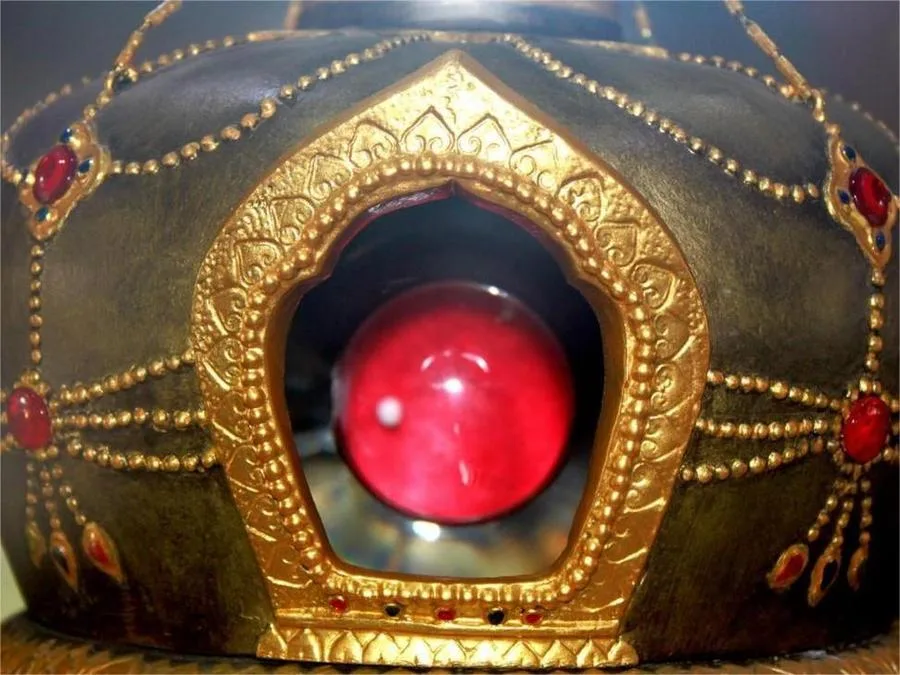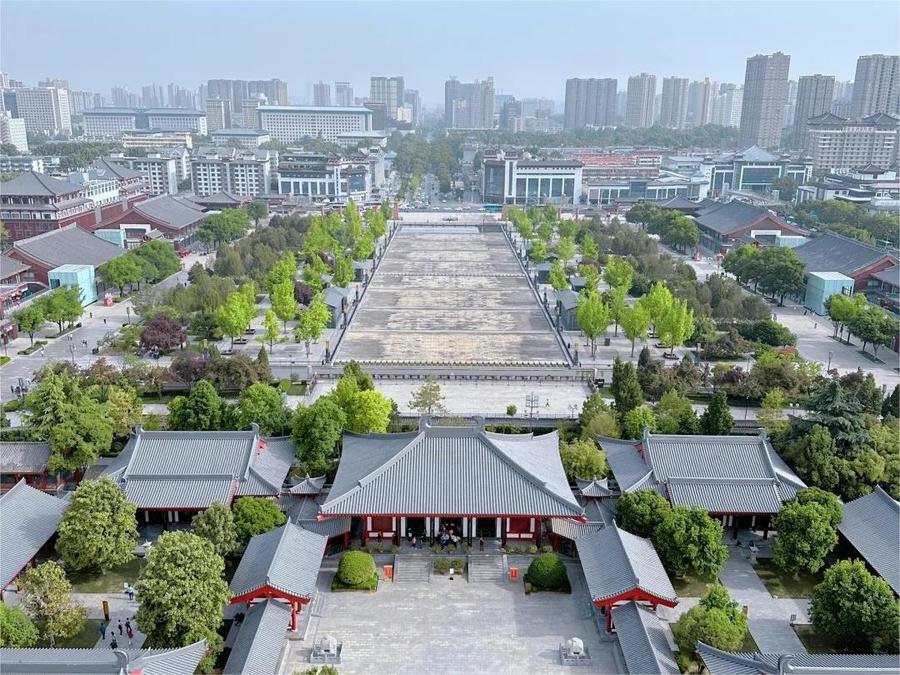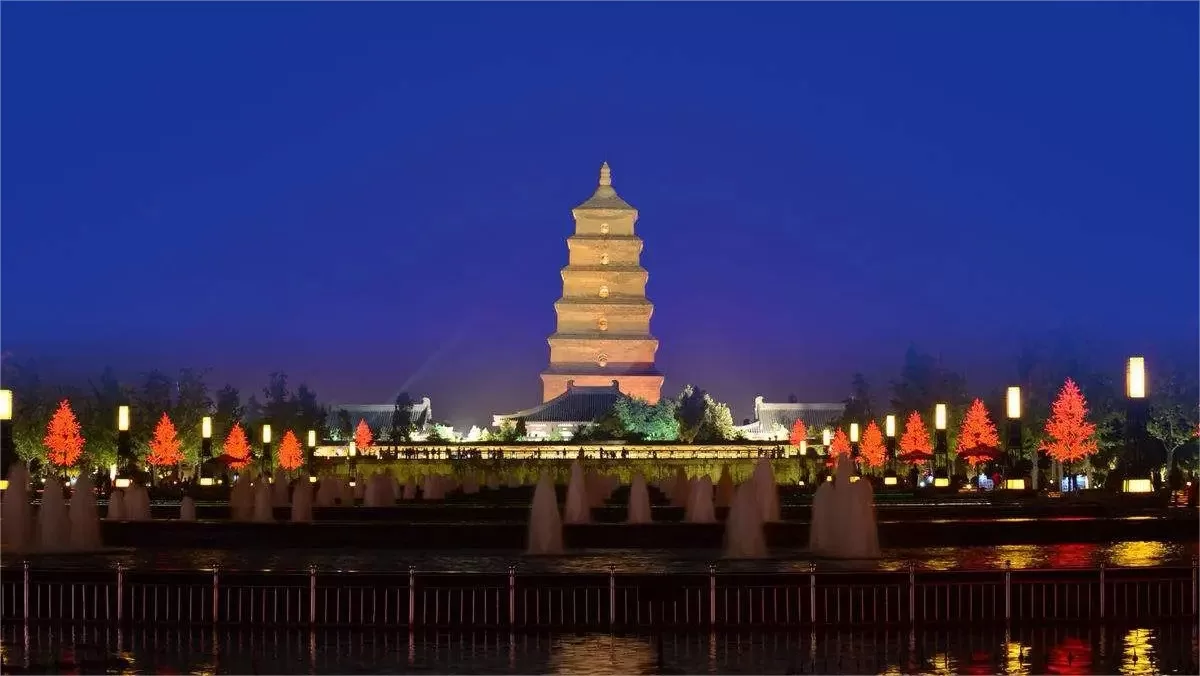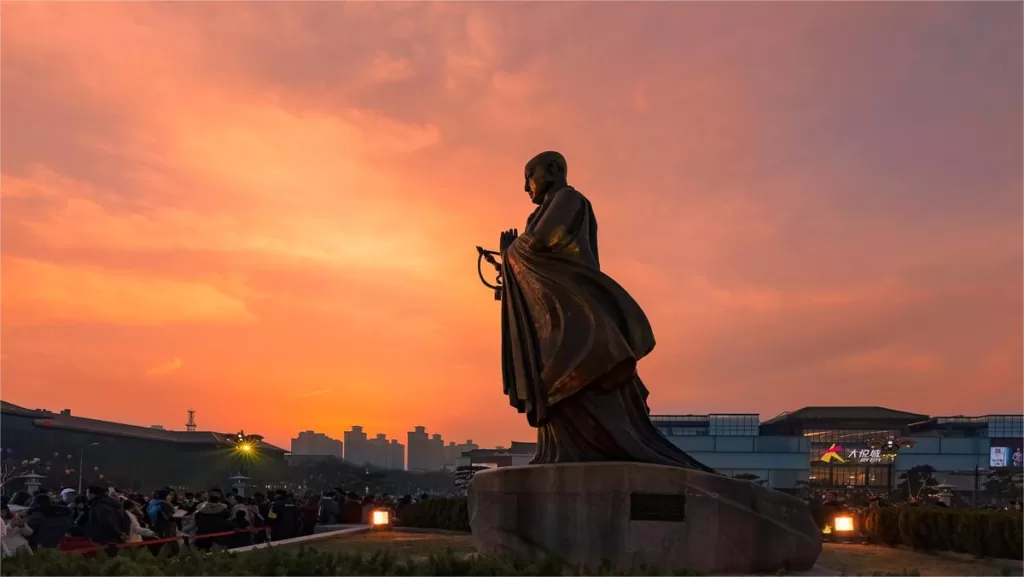The Giant Wild Goose Pagoda (大雁塔, Dayanta), also known as the Ci’en Temple Pagoda, stands within the Ci’en Temple in Jinchangfang, Tang Chang’an City (now located in the southern part of Xi’an, Shaanxi Province). It was constructed under the supervision of the renowned Tang Dynasty monk Xuanzang in the third year of the Yonghui era (652 AD) to preserve Buddhist scriptures and statues brought from India via the Silk Road to Chang’an.
Originally built with five stories, it was later expanded to nine stories, undergoing several alterations in height and number of stories before settling on its current form of a seven-story structure. Standing at a height of 64.517 meters with a base length of 25.5 meters, it is a prominent example of Tang-era square brick pagodas and represents the fusion of Indian Buddhist architectural styles with Chinese cultural elements.
As one of the earliest and largest surviving Tang Dynasty pagodas, the Giant Wild Goose Pagoda exemplifies the architectural form of square pavilion-style pagodas that were introduced to China along with Buddhism and subsequently integrated into Chinese culture. Its significance lies not only in its architectural and historical importance but also in its representation of the cultural exchange facilitated by the Silk Road.
In recognition of its historical and cultural significance, the Giant Wild Goose Pagoda was inscribed on the UNESCO World Heritage List on June 22, 2014, during the 38th session of the UNESCO World Heritage Committee held in Doha, Qatar.
Table of Contents
- Basic Information
- Location and Transportation
- Highlights of GIant Wild Goose Pagoda
- Vlog about Giant Wild Goose Pagoda
- Photography Spots and Tips
- Popular Restaurants near the Pagoda
- Origin of Giant Wild Goose Pagoda
- Useful Tips Summarized from Reviews
- Facts about Xuanzang
Basic Information
| Estimated Length of Tour | Less than an hour |
| Opening Hours | 8.30 – 17.30; Last entry: 16.50 |
| Ticket Price | The Giant Wild Goose Pagoda is in Daci’en Temple. A ticket to the Temple costs 50 RMB. It is free of charge to appreciate the pagoda on the ground. But if you want to climb it, you need to pay another 25 RMB |
Location and Transportation
The Giant Wild Goose Pagoda is in the southern part of Xi’an, in the Da Ci’en Complex, near the Shaanxi History Museum, about 4 kilometers from the city center, and is easily accessible by public transportation. The specific address is No. 4 Ci’en Road, Yanta District, Xi’an, Shanxi, China.
Bus: Take bus No. 21, 22, 23, 24, 44, 189, 224, 242, 271, 307, 408, 500, 526, 601, 606, or 609, get off at Yantaxilu Dongkou Stop (The East Side of Yanta West Road), and walk 50 meters to the east to reach the tourist spot
Subway: Take subway line 3 or 4, get off at Dayanta Station (Giant Wild Goose Pagoda Station), and walk 500 meters to the south to reach the entrance.
Self-drive: There are two parking lots to the south of the pagoda. But they are normally full unless you arrive really early in the morning.
Highlights of GIant Wild Goose Pagoda
Base of the Giant Wild Goose Pagoda
Masterpieces Tablet

The base of the Giant Wild Goose Pagoda is adorned with intricately carved stone door frames and lintels, showcasing exquisite Buddhist images and brick-carved couplets. On the south entrance of the ground floor, two stone tablets are embedded in the walls. The tablet in the western niche contains the “Preface to the Sacred Teachings of the Great Tang Tripitaka,” written by Emperor Taizong of Tang, Li Shimin, and hand-copied by Chu Suiliang, a renowned calligrapher. In the eastern niche is the “Record of the Preface to the Sacred Teachings of the Great Tang Tripitaka,” also composed by Emperor Gaozong of Tang, Li Zhi, and calligraphed by Chu Suiliang. These tablets are collectively known as the “Two Saints and Three Masterpieces Tablet.” Both tablets are intricately designed, featuring a rounded top with a dragon head and a trapezoidal body, typical of Tang-era stone tablets. They stand at 337.5 cm tall with a width of 86 cm at the top and 100 cm at the bottom. The inscriptions on these tablets praise the historical achievements and extraordinary spirit of Xuanzang, who traveled to the Western Regions to retrieve Buddhist scriptures and propagate Buddhism.
Murals and Patterns

These two stone tablets were erected by Xuanzang himself in October of the fourth year of the Yonghui reign of Emperor Gaozong (653 AD) and have been well preserved to this day. They are important cultural relics for studying Tang Dynasty calligraphy, painting, and carving arts. It is worth noting that renowned Tang Dynasty artists such as Wu Daozi and famous poet Wang Wei created many murals for the Ci’en Temple, although these have long been lost to history. However, the exquisitely carved lines on the lintels and door frames of the four entrances to the Giant Wild Goose Pagoda still retain traces of Tang Dynasty craftsmanship. Additionally, on the south entrance of the pagoda, there are embedded stone carvings depicting “Xuanzang’s Journey with Scriptures” and “Xuanzang Translating Scriptures,” providing visual narratives of Xuanzang’s legendary journey to the West and his tireless efforts, beginning with his footsteps.
Exhibitions of Chinese Pagodas

Furthermore, inside the ground floor of the pagoda, there is an exhibition showcasing ancient pagoda knowledge and photographs of famous Chinese pagodas, illustrating the origins, development, structure, and classification of Buddhist pagodas. Alongside the entrance path on the east side of the base, there lies a stone slab engraved with the “Footprint Stone of Xuanzang’s Journey with Scriptures,” vividly depicting the legendary story of Xuanzang’s journey to the West and his spirit of perseverance, which began with a single step.
Body of the Giant Wild Goose Pagoda
Gilded Bronze Statue of Shakyamuni Buddha

Ascending to the second floor of the pagoda, visitors are greeted by the resplendent figure of a gilded bronze statue of Shakyamuni Buddha, a priceless treasure dating back to the Ming Dynasty. This statue, revered as the “Treasure of the Stupa,” attracts throngs of worshippers who come to pay homage and seek blessings. Adorning the walls on either side are two murals depicting Manjushri Bodhisattva and Samantabhadra Bodhisattva, along with calligraphic works by contemporary luminaries, many of which are inspired by the sentiments of Tang Dynasty poets who visited the Giant Wild Goose Pagoda.
Buddhist Relics and the Pagoda’s Model

In the center of the third-floor chamber rests a wooden platform, atop which lie precious Buddhist relics and a meticulously crafted model of the Giant Wild Goose Pagoda. These relics, gifted by Master Wuchan, the abbot of Xuanzang Monastery in India, are considered invaluable treasures of Buddhism. The scale model of the pagoda, built to a precise ratio of 1:60, is a marvel of craftsmanship, faithfully replicating every detail of the structure.
Palm-leaf Manuscripts

The fourth-floor chamber houses two palm-leaf manuscripts, approximately 40 cm long and 7 cm wide, inscribed with densely packed Sanskrit characters. It is said that fewer than ten scholars worldwide possess the ability to decipher this ancient script, underscoring the precious and mysterious nature of these manuscripts. Palm-leaf manuscripts, also known as “Bhurja Patra,” were commonly used for writing in ancient India, with Xuanzang bringing back 657 such manuscripts along the Silk Road.
Footprint of Shakyamuni Buddha

On the fifth floor, visitors encounter a stele bearing the footprint of Shakyamuni Buddha, meticulously replicated based on a statue carved by the sculptor Li Tianzhao at the Yuhua Temple in Tongchuan during Xuanzang’s later years. Adorned with numerous Buddhist motifs, this stele is rich in symbolism and is often associated with the saying “Seeing the footprints is like seeing the Buddha; bowing to the footprints is like bowing to the Buddha.” Additionally, the fifth-floor chamber showcases several lesser-known poems written by Xuanzang, providing insights into his profound poetic talent.
Masterpiece Poems

The sixth floor features poems composed by five Tang Dynasty poets during a literary gathering held at the pagoda. In the late autumn of the eleventh year of the Tianbao era (752 AD), the renowned poet Du Fu, along with Cen Can, Gao Shi, Xue Ju, and Chu Guangxi, ascended the Giant Wild Goose Pagoda, drawing inspiration from the panoramic views and exchanging heartfelt verses over wine. Each poet crafted a magnificent five-character poem, with their literary masterpieces transcending time and continuing to resonate through the ages.
Panoramic Views

Finally, reaching the seventh floor, visitors are rewarded with panoramic views of the ancient city and its surroundings. The apex of the pagoda is adorned with a sacred lotus-shaped ceiling, featuring a central lotus surrounded by fourteen characters forming a poetic verse that can be recited in multiple ways. Inscriptions on the walls recount the legend of monks burying swallows to construct pagodas, as chronicled in Xuanzang’s “Records of the Western Regions,” offering visitors the most plausible explanation for the origins of the Giant Wild Goose Pagoda.
Vlog about Giant Wild Goose Pagoda
Photography Spots and Tips
Tang Daci’en Temple Ruins Park:
- Description: This park offers a stunning view of both the Giant Wild Goose Pagoda and the Buddha statue. It’s an ideal spot for capturing the pagoda with fewer crowds, beautiful scenery, and a serene atmosphere. The park is free to enter and does not require a reservation.
- Tip: Aim to take your photos during the golden hours (early morning or late afternoon) for the best lighting and to capture the pagoda against a vibrant sky.
South Plaza of Giant Wild Goose Pagoda:
- Description: This location provides a chance to frame the pagoda with the statue of Xuanzang (a famous monk) in the foreground. While it can be crowded, using a zoom lens can help you isolate the pagoda and monk, creating a clean composition.
- Tip: Shoot from a low angle looking up at the pagoda to emphasize its towering height and grandeur. Weekends may be busy, so an early visit is recommended.
Top Deck of Joy City Mall:
- Description: The mall’s rooftop offers multiple shooting locations with expansive views of the Giant Wild Goose Pagoda. The large terrace provides plenty of space, and the mall features various photo spots such as interactive installations and themed areas.
- Tip: Explore the rooftop’s different angles and setups for diverse shots. For a more playful experience, visit the top floor of the mall’s adjacent coffee shop to enjoy a drink while photographing.
Red Wall in Front of Joy City Mall Gate 3:
- Description: The red walls combined with green trees and the Giant Wild Goose Pagoda create a striking visual contrast. The color layers and the direct access via the elevator make it an easy and effective spot for photos.
- Tip: Capture photos with the red wall as a backdrop to add depth and vibrancy to your images. Experiment with different angles and framing to enhance the visual appeal.
Popular Restaurants near the Pagoda
Ziwu Road Zhangji Roujiamo (Cuihua Road Branch) [子午路张记肉夹馍(翠华路店)]:
- Description: This renowned eatery is famous for its Roujiamo (Chinese-style meat sandwich) and is located just a 10-15 minute walk from the pagoda. The Roujiamo is known for its tender meat and crispy bread. The meat tends to be a bit salty, so it’s recommended to go for the regular mix of lean and fatty meat for a balanced flavor. Pair your meal with a small bowl of meatball soup, and avoid the cold noodles.
- Tip: Freshly baked bread makes the sandwich even more delicious. If you prefer lean meat, be aware that it might be less flavorful compared to the mixed meat option.
Qiming Liji Rou (Cuihua Road Main Store) [启明腊汁肉揪面片(翠华路总店)]:
- Description: Located next door to the Cuihua Road branch of Zhangji Roujiamo, Qiming Liji Rou specializes in Liji Rou (braised meat) and Jiu Mian Pian (hand-cut noodles). The braised meat is similar to what you get in Roujiamo, and the noodles are wide and hearty. It’s a very authentic experience with local flavors.
- Tip: Try their dishes with a glass of Bingfeng, a popular local soda, to complete the traditional Xi’an experience.
Huzi Shui Pen Yang Rou (Cuihua Road Flagship Store) [虎子水盆羊肉(翠华路旗舰店)]:
- Description: Known for its affordable prices and hearty portions, Huzi Shui Pen Yang Rou offers thick slices of lamb in a flavorful broth. It’s a popular choice for those who enjoy lamb dishes. The restaurant’s prices are lower compared to other places, and the lamb and bread are both well-prepared.
- Tip: The spicy garlic lamb blood and fresh bread are must-tries. The restaurant’s pricing makes it a great option for a budget-friendly meal.
Da Xiang Biangbiang Noodles (Giant Wild Goose Pagoda Store) [大嘻咹biangbiang面(大雁塔店)]:
- Description: This small but clean restaurant specializes in Biangbiang Noodles, a local favorite. The noodles are known for their chewy texture, and the service is attentive. It’s conveniently located next to the Giant Wild Goose Pagoda Metro Station (Exit E), offering good value for money.
- Tip: The restaurant can get busy at lunchtime, so try to visit either early or late to avoid the rush. The noodles are the highlight, so make sure to try them with their special sauce.
Origin of Giant Wild Goose Pagoda
The origin of the Giant Wild Goose Pagoda dates back to the third year of the Yonghui era in the Tang Dynasty, around 652 AD. At this time, the eminent monk Xuanzang, renowned for his pilgrimage to India in search of Buddhist scriptures and knowledge, initiated the construction of a five-story brick pagoda within the West Court of the Ci’en Temple in Chang’an. This initiative was undertaken to house and honor the Buddha statues, relics, and Sanskrit scriptures brought back from India.
The site of the Ci’en Temple has a rich history preceding the construction of the pagoda. Initially, during the Northern Wei Dynasty, Emperor Daowu established the Jingjue Monastery at this location. Later, during the Sui Dynasty, Emperor Wen of Sui constructed the Wulou Monastery on the site of the former Jingjue Monastery. However, this monastery was eventually abandoned.
In the year 648 AD, in honor of his deceased mother, Empress Wende, Crown Prince Li Zhi, who later became Emperor Gaozong of Tang, petitioned Emperor Taizong to construct a Buddhist temple and named it the Ci’en Temple. Xuanzang was invited to serve as the chief monk of the temple upon its completion. Under his guidance, the Ci’en Temple became a center for the translation and preservation of Buddhist scriptures and teachings, particularly those of the Mahayana Buddhist tradition.
The impetus for the construction of the Giant Wild Goose Pagoda came from Xuanzang’s concern for the preservation of Buddhist scriptures and relics. He proposed the construction of a 90-meter stone pagoda outside the main gate of the Ci’en Temple to safeguard these precious artifacts from loss or damage due to human negligence or fire hazards. However, due to the monumental scale of the proposed project and Emperor Taizong’s reluctance to burden Xuanzang with such labor-intensive tasks, the emperor instead granted funds for the construction of a five-story brick pagoda within the temple’s western courtyard.
Originally named the Wild Goose Tower (Yanta), the pagoda was later referred to as the Giant Wild Goose Pagoda to distinguish it from a smaller pagoda of the same name built within the Jianfu Temple in Chang’an. The construction of the pagoda, supervised by Xuanzang himself, took two years to complete. It followed the architectural style of the stupa found in the Western Regions, featuring a brick exterior and a solid interior, with each story housing Buddhist relics.
Useful Tips Summarized from Reviews
Choosing Photo Spots: If you’re aiming for picturesque photo opportunities, you don’t necessarily need to enter the Da Ci’en Temple. The best photo spot is actually near the Xuanzang Bronze Statue on the square. For photos with the red wall, head to the area beside the Dayuecheng Mall.
Evening Photography: The lighting around the Giant Wild Goose Pagoda may not be as vibrant in the evening, especially during the winter when the air in Xi’an tends to be hazy. Therefore, evening might not be the best time for capturing photos of the pagoda.
Understanding the History: If you’re interested in learning about the history of the Great Ci’en Temple, it’s essential to enter the temple and take a guided tour. Without a guide, you might only see a temple and a pagoda without understanding their historical significance.
Evening Activities: At 7:00 PM, head to the North Square of the Giant Wild Goose Pagoda to watch the musical fountain show. Afterward, stroll from north to south, passing through “Poetic Chang’an” to admire the poetry lanterns hanging from trees, creating a romantic atmosphere. Continue walking until you reach the east side of Kaiyuan Square to watch the outdoor puppet show at 8:15 PM (which is distant and not interactive). Alternatively, queue up before 8:30 PM for the indoor puppet show at 9:30 PM (which is closer and interactive).
Choosing the Right Day: If you have flexibility in your schedule, consider visiting on a Sunday, as it tends to be less crowded compared to Saturdays.







The only impressive aspect of the Big Wild Goose Pagoda might be the fountain show. It’s quite spectacular. However, there were so many people that it didn’t take long before someone approached me saying, “Would you like to try on a Hanfu?”.
The Big Wild Goose Pagoda consists of seven floors, and as you ascend, the view becomes broader. However, the scenery on each floor is quite similar overall. After the second floor, there is only one staircase for going up and down, which is relatively narrow. If there are many visitors, it could lead to congestion. The Daci’en Temple stops admitting visitors at 5 PM and closes at 6 PM. It is recommended to allocate a total of two hours for… Read more »
The Big Wild Goose Pagoda gives me a different feeling compared to other pagodas I’ve seen elsewhere. I believe it’s because there are no other buildings around it, allowing it to stand out uniquely on the vast plain, exuding an ancient charm.
March 4th marks the anniversary of Master Xuanzang’s passing.
The Da Ci’en Temple is open for free, and the site was bustling with crowds.
On that day, a memorial service was held in honor of Master Xuanzang.
The underground palace was open for visitors to pay their respects to Master Xuanzang’s relics!
Unfortunately, I arrived late; although I didn’t have to endure the hardships of waiting in line, I also missed out on the opportunity to enjoy the vegetarian meal.
The Big Wild Goose Pagoda is surrounded by the bustling Tang Ever Bright City, and there were just too many people — there were heads everywhere!